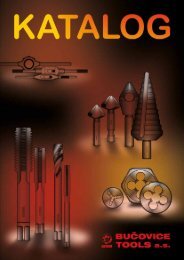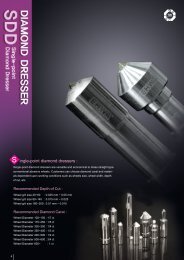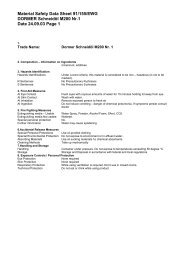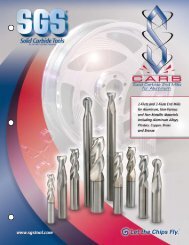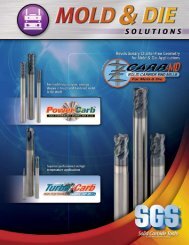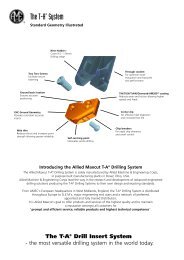Pages • Multi-Mat® Concept • Lamina Multi-Mat® full ... - Tikontools
Pages • Multi-Mat® Concept • Lamina Multi-Mat® full ... - Tikontools
Pages • Multi-Mat® Concept • Lamina Multi-Mat® full ... - Tikontools
You also want an ePaper? Increase the reach of your titles
YUMPU automatically turns print PDFs into web optimized ePapers that Google loves.
Material Group<br />
Nickel Based Alloys<br />
Titanium Based<br />
Alloys<br />
Group hardness<br />
Material Examples<br />
No<br />
HB Coolant<br />
feed per tooth<br />
o o<br />
45 90<br />
Initial<br />
Vc(m/min)<br />
150 300<br />
XC 12<br />
Low Carbon Steel 1 180 No 0.30 0.22 270<br />
S 250 Pb<br />
210 230<br />
Alloy Steel 2<br />
High Alloy Steel 3<br />
Austenitic<br />
Stainless Steel<br />
4<br />
42 CrMo 4<br />
100 Cr 6<br />
32 NiCrMo 14.5<br />
X38 CrMoV 5<br />
X210 CrW 12<br />
X90 CrMoV 8<br />
303 / 304<br />
304 L<br />
180 230<br />
230<br />
190<br />
No 0.25 0.18<br />
280 170<br />
320 150<br />
220<br />
280<br />
320<br />
Yes<br />
Yes<br />
no<br />
0.22 0.15<br />
150<br />
110<br />
100<br />
350 70<br />
Annealed<br />
5 316 / 316 L Annealed<br />
6<br />
316 Ti<br />
630 (F16PH)<br />
No<br />
0.27 0.18 230<br />
0.25 0.15 210<br />
0.23 0.12 90<br />
Ferritic Stainless<br />
Steel<br />
7 430 / 439 / 444 Annealed No 0.25 0.15 210<br />
Martensitic<br />
Stainless Steel<br />
8 410 / 420<br />
Annealed<br />
Treated<br />
No 0.25 0.15<br />
210<br />
130<br />
Grey Cast Iron 9<br />
EN-GJL 200<br />
EN-GJL 250<br />
EN-GJL 300<br />
140<br />
to 250<br />
Yes 0.30 0.18<br />
250<br />
230<br />
190<br />
EN-GJL 400 210<br />
190<br />
Nodular Cast Iron 10 EN-GJL 600 260 Yes 0.25 0.15 150<br />
Aluminium<br />
Basic cutting conditions for first time user - Milling<br />
EN-GJL 800 310 130<br />
Inconel 625 32<br />
11 Inconel 718 -------- Yes 0.23 0.15 32<br />
12<br />
13<br />
Aluminium 14<br />
4<br />
First time <strong>Lamina</strong> user Machining guide<br />
As a new user of the revolutionary <strong>Lamina</strong> <strong>Multi</strong>-Mat ® (<strong>Multi</strong> Material) inserts,<br />
we would like to present to you a short machining guide to insure your<br />
satisfaction from our product.<br />
The cutting data specified in this guide should be considered as a good starting<br />
point. Each insert is able to perform in a wider range of cutting conditions.<br />
For complete cutting data please see our catalog or our online catalog at our web<br />
site www.lamina-tech.ch<br />
Milling<br />
. Select the material group to be machined. In case of doubt, refer to material reference pages in the catalog.<br />
2. Check machining recommendations with or without coolant.<br />
3. Select feed as a function of the tool cutting angle.<br />
4. The cutting speed is indicated in the right-hand column.<br />
Yes / No<br />
Yes<br />
Hastelloy C 55<br />
TiAl 6 V4<br />
48<br />
-------- Yes 0.23 0.15<br />
T40 38<br />
Si < 4%<br />
4% < Si < 8%<br />
Si > 8%<br />
Annealed<br />
----<br />
----<br />
Yes<br />
0.25 0.15<br />
0.18<br />
0.12<br />
800<br />
450<br />
For Alu group 13, please use our Alu line grade LT-05<br />
---- Yes 0.25 0.15 250<br />
For Alu group 14, please use inserts grade LT-10<br />
Milling tips<br />
<strong>•</strong> The cutting conditions mentioned are<br />
just initial recommendations. Inserts<br />
are able to work in a wider range of<br />
cutting conditions. For detailed cutting<br />
conditions, please see catalog.<br />
<strong>•</strong> Please verify working according to<br />
recommended cutting conditions.<br />
<strong>•</strong> For stainless steel, verify that you are<br />
machining well over the minimum<br />
speed. Machining Stainless steel at low<br />
speeds causes sticking - to be avoided.<br />
<strong>•</strong> For material groups 1 / 2 / 4 / 7 / 8, it is<br />
recommended not to use coolant.<br />
<strong>•</strong> For material groups 6 and 12, it is<br />
recommended to use coolant.<br />
<strong>•</strong> For other material groups both, with<br />
or without coolant options should be<br />
checked.<br />
<strong>•</strong> Always recommended to machine in<br />
"climb" milling.<br />
<strong>•</strong> If chips are turning with cutter, increase<br />
cutting speed, feed or both.<br />
<strong>•</strong> If work piece warms up, feed is too low<br />
or cutting speed is too high.<br />
<strong>•</strong> Shank should be as short as possible and<br />
shank diameter as big as possible.<br />
<strong>•</strong> Verify clamping stability.<br />
<strong>•</strong> If coolant is not efficient enough, it is<br />
recommended not to use coolant.<br />
<strong>•</strong> In case of vibrations, reduce cutting<br />
speed and/or increase feed.<br />
The above values are indicated as functions of<br />
the cutting edge angle, i.e. kappa 45° or 90°. The<br />
high feed relates to cutting inserts for surfacing,<br />
attack angles 45° and 75°. The low feed relates<br />
to cutting inserts for surfacing, trimming angle<br />
90°. The above-mentioned cutting conditions<br />
are indicated for each material group and the<br />
respective hardness.<br />
Turning<br />
. Select the material group to be machined. In case of<br />
doubt, consult material reference pages in the catalog.<br />
2. Select the radius of the cutting insert.<br />
3. Select cutting depth and feed according to radius.<br />
4. The cutting speed is indicated in the right-hand column.<br />
Turning tips<br />
<strong>•</strong> The cutting conditions mentioned are just initial<br />
recommendations. Inserts are able to work in a wider range of<br />
cutting conditions. For detailed cutting conditions, please see<br />
catalog.<br />
<strong>•</strong> Please verify working according to recommended cutting<br />
conditions.<br />
<strong>•</strong> If you are working according to the cutting conditions in the<br />
catalog, Amax must be respected.<br />
<strong>•</strong> For stainless Steel, verify that you are machining well over the<br />
minimum speed. Machining Stainless steel at low speeds causes<br />
sticking – to be avoided.<br />
Titanium Based<br />
Alloys<br />
<strong>•</strong> For stainless Steel and Exotic materials, without interrupted cut,<br />
P insert is preferable (CNMP, WNMP).<br />
<strong>•</strong> For all material groups, it is recommended to use coolant.<br />
<strong>•</strong> Verify that the tool holder and shim are not damaged.<br />
<strong>•</strong> If chips are too long, please increase feed.<br />
<strong>•</strong> If chips are not controlled, increase feed and reduce depth of<br />
cut.<br />
<strong>•</strong> For internal boring, tool holder should be as short as possible.<br />
<strong>•</strong> For internal boring, tool holder shank should be as big as<br />
possible.<br />
<strong>•</strong> For internal boring, in case of vibrations, reduce cutting speed,<br />
increase feed.<br />
<strong>•</strong> If coolant is not efficient enough, it is recommended not to<br />
use coolant.<br />
<strong>•</strong> In case of strong interrupted cut, feed should be reduced.<br />
Material Group<br />
Group<br />
Material Examples<br />
No<br />
hardness<br />
HB<br />
Nose radius 04<br />
(04)<br />
d.o.c f<br />
Nose radius 08<br />
(08)<br />
d.o.c f<br />
Nose radius 12<br />
(12)<br />
d.o.c f<br />
Initial<br />
Vc(m/min)<br />
Low Carbon Steel 1<br />
XC 12<br />
S 250 Pb<br />
150<br />
180<br />
210<br />
0.50<br />
to<br />
1.50<br />
0.10<br />
to<br />
0.15<br />
1.00<br />
to<br />
3.00<br />
0.22<br />
to<br />
0.28<br />
1.50<br />
to<br />
5.0<br />
0.35<br />
to<br />
0.50<br />
350<br />
280<br />
250<br />
Alloy Steel 2<br />
High Alloy Steel 3<br />
Austenitic<br />
Stainless Steel<br />
Ferritic Stainless<br />
Steel<br />
Martensitic<br />
Stainless Steel<br />
4<br />
303 / 304<br />
304 L<br />
180 270<br />
230<br />
280<br />
0.50<br />
to<br />
1.50<br />
0.10<br />
to<br />
0.12<br />
1.00<br />
to<br />
3.00<br />
0.22<br />
to<br />
0.28<br />
1.50<br />
to<br />
4.0<br />
0.32<br />
to<br />
0.45<br />
230<br />
190<br />
320 170<br />
220<br />
280<br />
320<br />
0.50<br />
to<br />
1.50<br />
0.10<br />
1.00<br />
to<br />
3.00<br />
0.20<br />
to<br />
0.25<br />
1.50<br />
to<br />
3.0<br />
0.30<br />
to<br />
0.42<br />
170<br />
130<br />
110<br />
350 90<br />
0.50 to 0.10 to 1.00 to 0.18 to 1.50 to 0.32 to<br />
5 316 / 316 L Annealed<br />
190<br />
1.50 0.12 3.00 0.25 4.0 0.48<br />
6<br />
316 Ti<br />
630 (F16PH)<br />
7 430 / 439 / 444 Annealed 0.50 to 0.12 to 1.00 to 0.22 to 1.50 to 0.32 to<br />
190<br />
1.50 0.15 3.00 0.28 4.0 0.48<br />
8 410 / 420<br />
Grey Cast Iron 9<br />
EN-GJL 200<br />
EN-GJL 250<br />
EN-GJL 300<br />
140<br />
to 250<br />
0.20<br />
to<br />
1.50<br />
0.08<br />
to<br />
0.15<br />
1.00<br />
to<br />
4.00<br />
0.18<br />
to<br />
0.35<br />
1.00<br />
to<br />
5.00<br />
0.32<br />
to<br />
0.60<br />
270<br />
230<br />
210<br />
EN-GJL 400<br />
210 0.20 0.10 1.00 0.18 1.00 0.30 210<br />
Nodular Cast Iron 10 EN-GJL 600<br />
260 to to to to to to 170<br />
EN-GJL 800<br />
310 1.50 0.12 3.00 0.30 5.00 0.50<br />
150<br />
Inconel 625<br />
0.20 0.10 1.00 0.18 1.00 0.30 35<br />
Nickel Based Alloys 11 Inconel 718 -------- to to to to to to 38<br />
Hastelloy C 1.20 0.12 3.00 0.28 3.00 0.42 65<br />
Aluminium<br />
Basic cutting conditions for first time user - Turning<br />
12<br />
13<br />
Aluminium 14<br />
42 CrMo 4<br />
100 Cr 6<br />
32 NiCrMo 14.5<br />
X38 CrMoV 5<br />
X210 CrW 12<br />
X90 CrMoV 8<br />
0.50 to<br />
1.50<br />
0.50 to<br />
1.20<br />
0.12 to<br />
0.15<br />
0.11<br />
TiAl 6 V4<br />
0.20 to 0.10 to 1.00 to 0.18 to 1.00 to 0.32 to 55<br />
--------<br />
T40 1.20 0.14 3.00 0.32 4.00 0.45 42<br />
Si < 4%<br />
4% < Si < 8%<br />
Si > 8%<br />
Annealed<br />
Annealed<br />
Annealed<br />
Treated<br />
----<br />
----<br />
----<br />
0.50 to<br />
1.50<br />
0.20 to<br />
5.00<br />
0.12 to<br />
0.15<br />
0.12 to<br />
0.25<br />
1.00 to<br />
3.00<br />
1.00 to<br />
2.50<br />
1.00 to<br />
3.00<br />
0.20 to<br />
5.00<br />
0.18 to<br />
0.32<br />
0.18 to<br />
0.23<br />
0.22 to<br />
0.28<br />
0.15 to<br />
0.50<br />
For Alu group 13, please use our Alu line grade LT-05<br />
1.50 to<br />
5.0<br />
1.50 to<br />
3.0<br />
1.50 to<br />
4.0<br />
0.35 to<br />
0.52<br />
0.30 to<br />
0.45<br />
0.32 to<br />
0.48<br />
0.50-5.00 0.12-0.20 0.50-5.00 0.15-0.40 0.50-5.00 0.20-0.60<br />
For Alu group 14, please use inserts grade LT-10<br />
230<br />
110<br />
190<br />
150<br />
800<br />
450<br />
250<br />
5



